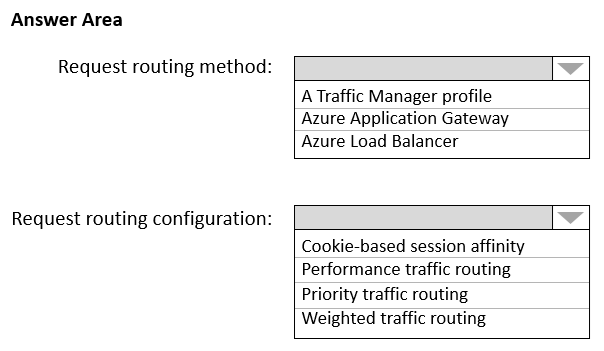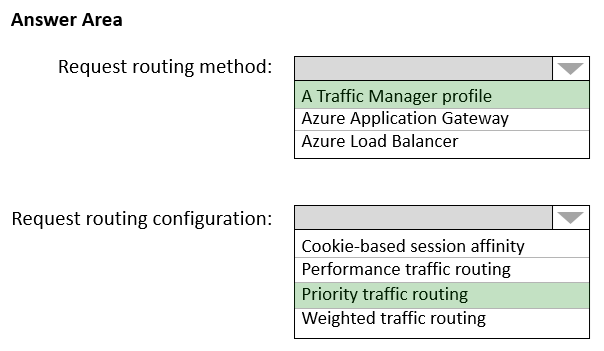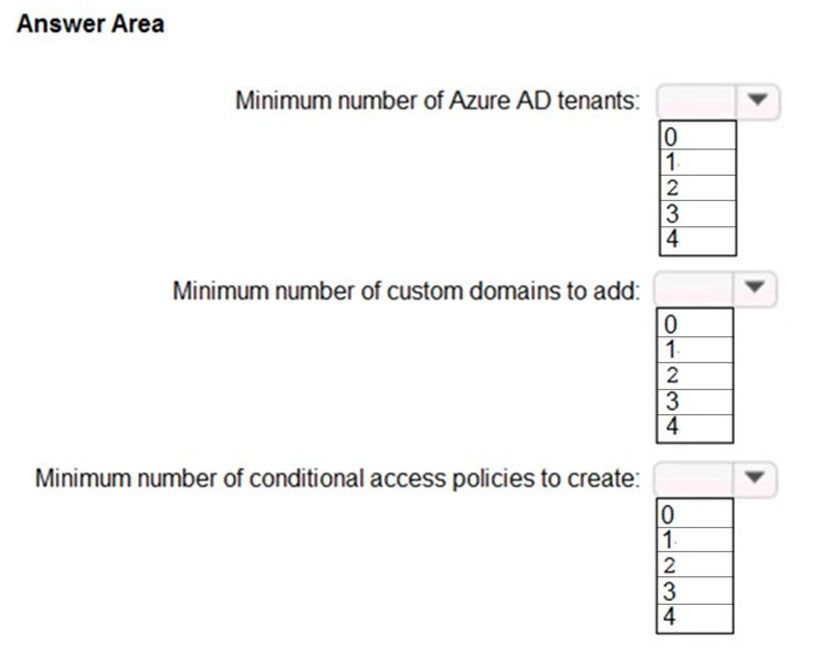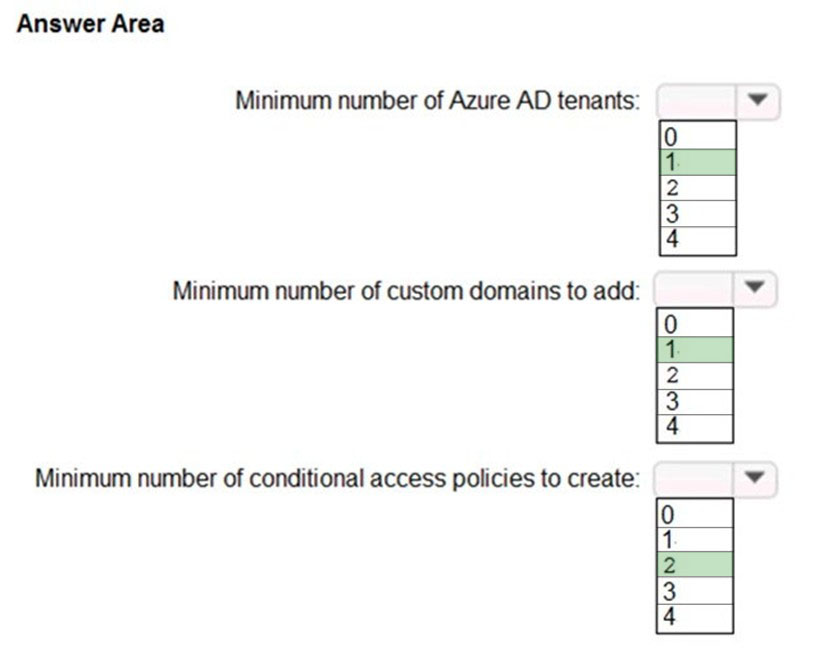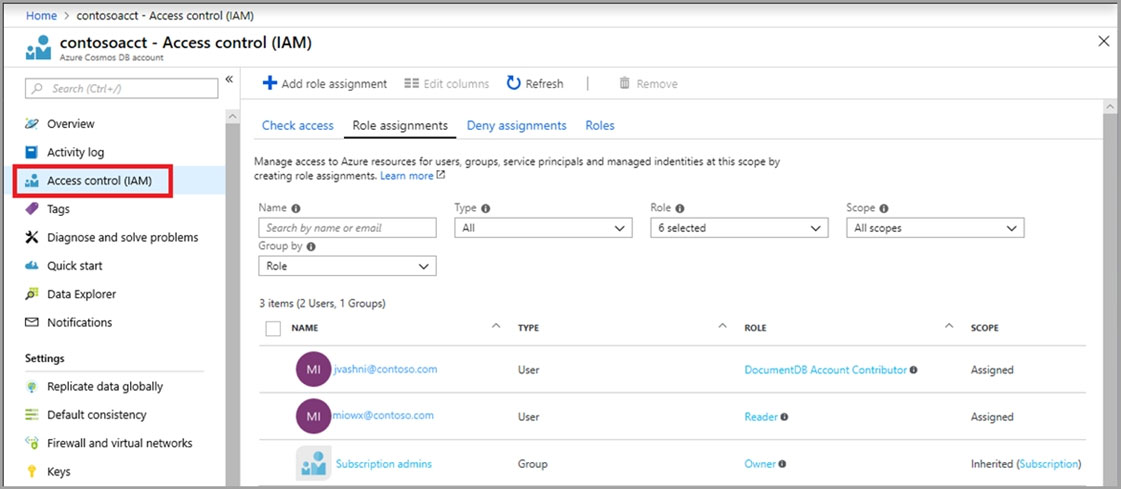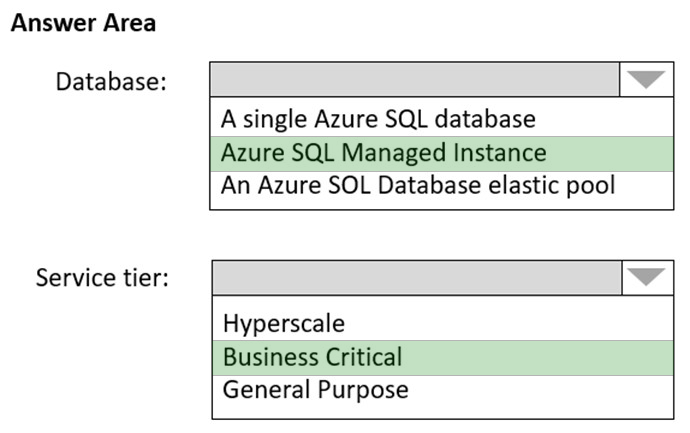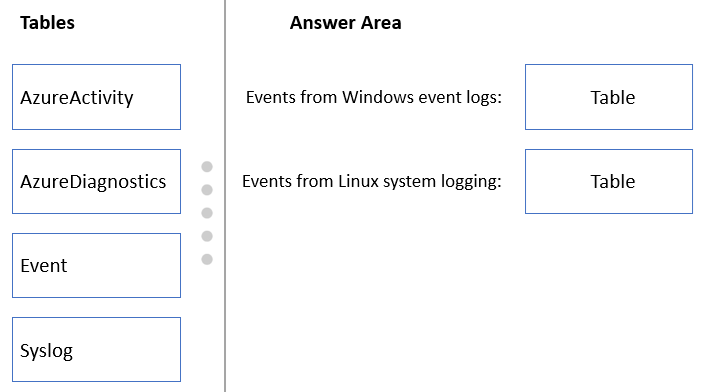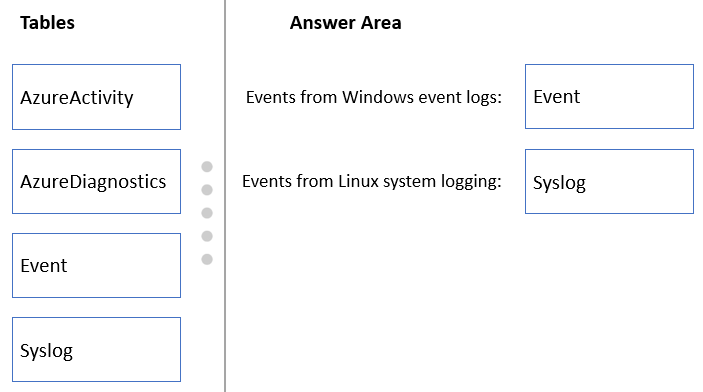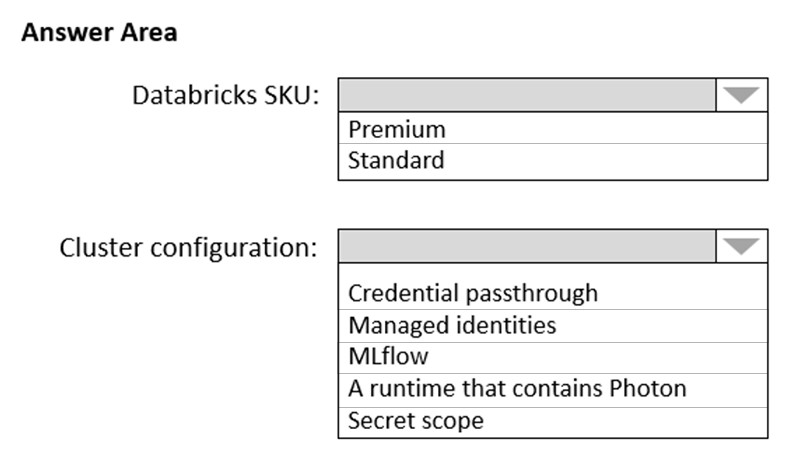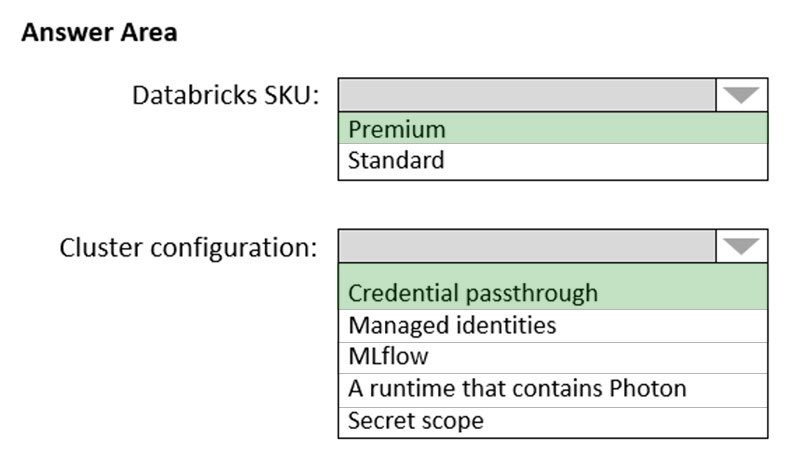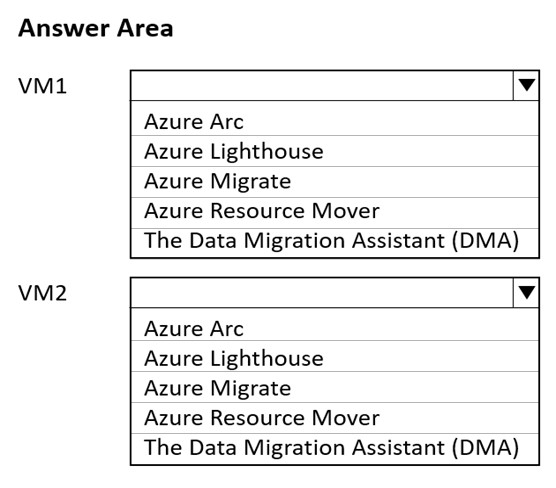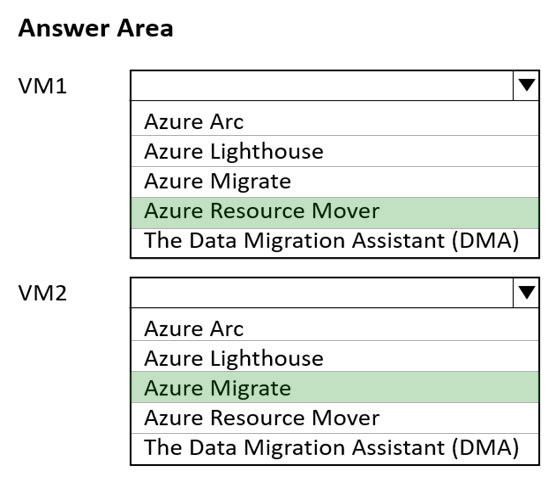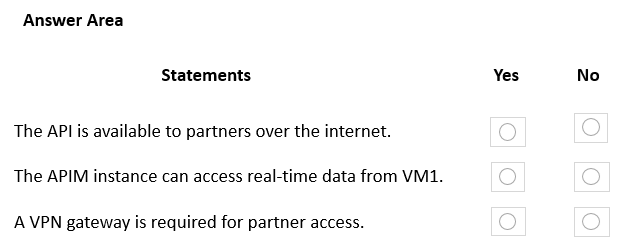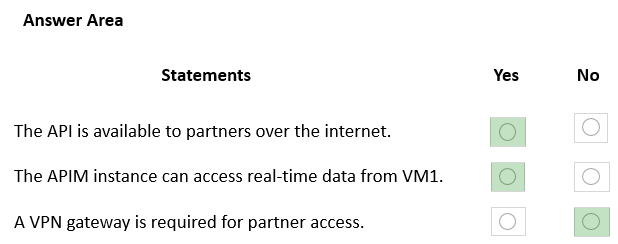AZ-305 Dump Free – 50 Practice Questions to Sharpen Your Exam Readiness.
Looking for a reliable way to prepare for your AZ-305 certification? Our AZ-305 Dump Free includes 50 exam-style practice questions designed to reflect real test scenarios—helping you study smarter and pass with confidence.
Using an AZ-305 dump free set of questions can give you an edge in your exam prep by helping you:
- Understand the format and types of questions you’ll face
- Pinpoint weak areas and focus your study efforts
- Boost your confidence with realistic question practice
Below, you will find 50 free questions from our AZ-305 Dump Free collection. These cover key topics and are structured to simulate the difficulty level of the real exam, making them a valuable tool for review or final prep.
HOTSPOT - You are designing an Azure App Service web app. You plan to deploy the web app to the North Europe Azure region and the West Europe Azure region. You need to recommend a solution for the web app. The solution must meet the following requirements: ✑ Users must always access the web app from the North Europe region, unless the region fails. ✑ The web app must be available to users if an Azure region is unavailable. ✑ Deployment costs must be minimized. What should you include in the recommendation? To answer, select the appropriate options in the answer area. NOTE: Each correct selection is worth one point. Hot Area:
You are developing a sales application that will contain several Azure cloud services and handle different components of a transaction. Different cloud services will process customer orders, billing, payment, inventory, and shipping. You need to recommend a solution to enable the cloud services to asynchronously communicate transaction information by using XML messages. What should you include in the recommendation?
A. Azure Service Fabric
B. Azure Data Lake
C. Azure Service Bus
D. Azure Traffic Manager
DRAG DROP - You have an on-premises app named App1. Customers use App1 to manage digital images. You plan to migrate App1 to Azure. You need to recommend a data storage solution for App1. The solution must meet the following image storage requirements: • Encrypt images at rest. • Allow files up to 50 MB. • Manage access to the images by using Azure Web Application Firewall (WAF) on Azure Front Door. The solution must meet the following customer account requirements: • Support automatic scale out of the storage. • Maintain the availability of App1 if a datacenter fails. • Support reading and writing data from multiple Azure regions. Which service should you include in the recommendation for each type of data? To answer, drag the appropriate services to the correct type of data. Each service may be used once, more than once, or not at all. You may need to drag the split bar between panes or scroll to view content. NOTE: Each correct answer is worth one point.
Overview - Fabrikam, Inc. is an engineering company that has offices throughout Europe. The company has a main office in London and three branch offices in Amsterdam, Berlin, and Rome. Existing Environment: Active Directory Environment The network contains two Active Directory forests named corp.fabrikam.com and rd.fabrikam.com. There are no trust relationships between the forests. Corp.fabrikam.com is a production forest that contains identities used for internal user and computer authentication. Rd.fabrikam.com is used by the research and development (R&D) department only. The R&D department is restricted to using on-premises resources only. Existing Environment: Network Infrastructure Each office contains at least one domain controller from the corp.fabrikam.com domain. The main office contains all the domain controllers for the rd.fabrikam.com forest. All the offices have a high-speed connection to the internet. An existing application named WebApp1 is hosted in the data center of the London office. WebApp1 is used by customers to place and track orders. WebApp1 has a web tier that uses Microsoft Internet Information Services (IIS) and a database tier that runs Microsoft SQL Server 2016. The web tier and the database tier are deployed to virtual machines that run on Hyper-V. The IT department currently uses a separate Hyper-V environment to test updates to WebApp1. Fabrikam purchases all Microsoft licenses through a Microsoft Enterprise Agreement that includes Software Assurance. Existing Environment: Problem Statements The use of WebApp1 is unpredictable. At peak times, users often report delays. At other times, many resources for WebApp1 are underutilized. Requirements: Planned Changes - Fabrikam plans to move most of its production workloads to Azure during the next few years, including virtual machines that rely on Active Directory for authentication. As one of its first projects, the company plans to establish a hybrid identity model, facilitating an upcoming Microsoft 365 deployment. All R&D operations will remain on-premises. Fabrikam plans to migrate the production and test instances of WebApp1 to Azure. Requirements: Technical Requirements Fabrikam identifies the following technical requirements: Website content must be easily updated from a single point. User input must be minimized when provisioning new web app instances. Whenever possible, existing on-premises licenses must be used to reduce cost. Users must always authenticate by using their corp.fabrikam.com UPN identity. Any new deployments to Azure must be redundant in case an Azure region fails. Whenever possible, solutions must be deployed to Azure by using the Standard pricing tier of Azure App Service. An email distribution group named IT Support must be notified of any issues relating to the directory synchronization services. In the event that a link fails between Azure and the on-premises network, ensure that the virtual machines hosted in Azure can authenticate to Active Directory. Directory synchronization between Azure Active Directory (Azure AD) and corp.fabrikam.com must not be affected by a link failure between Azure and the on- premises network. Requirements: Database Requirements Fabrikam identifies the following database requirements: Database metrics for the production instance of WebApp1 must be available for analysis so that database administrators can optimize the performance settings. To avoid disrupting customer access, database downtime must be minimized when databases are migrated. Database backups must be retained for a minimum of seven years to meet compliance requirements. Requirements: Security Requirements Fabrikam identifies the following security requirements: Company information including policies, templates, and data must be inaccessible to anyone outside the company. Users on the on-premises network must be able to authenticate to corp.fabrikam.com if an internet link fails. Administrators must be able authenticate to the Azure portal by using their corp.fabrikam.com credentials. All administrative access to the Azure portal must be secured by using multi-factor authentication (MFA). The testing of WebApp1 updates must not be visible to anyone outside the company. HOTSPOT - To meet the authentication requirements of Fabrikam, what should you include in the solution? To answer, select the appropriate options in the answer area. NOTE: Each correct selection is worth one point. Hot Area:
HOTSPOT - Your on-premises datacenter contains a server named Server1 that runs Microsoft SQL Server 2022. Server1 contains a 30-TB database named DB1 that stores customer data. Server1 runs a custom application named App1 that verifies the compliance of records in DB1. App1 must run on the same server as DB1. You have an Azure subscription. You need to migrate DB1 to Azure. The solution must minimize administrative effort. To which service should you migrate DB1, and what should you use to perform the migration? To answer, select the appropriate options in the answer area. NOTE: Each correct selection is worth one point.
You plan to deploy an app that will use an Azure Storage account. You need to deploy the storage account. The storage account must meet the following requirements: ✑ Store the data for multiple users. ✑ Encrypt each user's data by using a separate key. ✑ Encrypt all the data in the storage account by using customer-managed keys. What should you deploy?
A. files in a premium file share storage account
B. blobs in a general purpose v2 storage account
C. blobs in an Azure Data Lake Storage Gen2 account
D. files in a general purpose v2 storage account
You have 100 Microsoft SQL Server Integration Services (SSIS) packages that are configured to use 10 on-premises SQL Server databases as their destinations. You plan to migrate the 10 on-premises databases to Azure SQL Database. You need to recommend a solution to create Azure-SQL Server Integration Services (SSIS) packages. The solution must ensure that the packages can target the SQL Database instances as their destinations. What should you include in the recommendation?
A. Data Migration Assistant (DMA)
B. Azure Data Factory
C. Azure Data Catalog
D. SQL Server Migration Assistant (SSMA)
You have an on-premises storage solution. You need to migrate the solution to Azure. The solution must support Hadoop Distributed File System (HDFS). What should you use?
A. Azure Data Lake Storage Gen2
B. Azure NetApp Files
C. Azure Data Share
D. Azure Table storage
You are designing an app that will use Azure Cosmos DB to collate sales from multiple countries. You need to recommend an API for the app. The solution must meet the following requirements: • Support SQL queries. • Support geo-replication. • Store and access data relationally. Which API should you recommend?
A. Apache Cassandra
B. PostgreSQL
C. MongoDB
D. NoSQL
HOTSPOT - You have an Azure subscription that contains the resources shown in the following table.You create an Azure SQL database named DB1 that is hosted in the East US Azure region. To DB1, you add a diagnostic setting named Settings1. Settings1 archive SQLInsights to storage1 and sends SQLInsights to Workspace1. For each of the following statements, select Yes if the statement is true. Otherwise, select No. Hot Area:
You are developing a sales application that will contain several Azure cloud services and handle different components of a transaction. Different cloud services will process customer orders, billing, payment, inventory, and shipping. You need to recommend a solution to enable the cloud services to asynchronously communicate transaction information by using XML messages. What should you include in the recommendation?
A. Azure Application Gateway
B. Azure Data Lake
C. Azure Queue Storage
D. Azure Blob Storage
Your company has the divisions shown in the following table.Sub1 contains an Azure App Service web app named App1. App1 uses Azure AD for single-tenant user authentication. Users from contoso.com can authenticate to App1. You need to recommend a solution to enable users in the fabrikam.com tenant to authenticate to App1. What should you recommend?
A. Configure the Azure AD provisioning service.
B. Enable Azure AD pass-through authentication and update the sign-in endpoint.
C. Configure Supported account types in the application registration and update the sign-in endpoint.
D. Configure Azure AD join.
You have an Azure Active Directory (Azure AD) tenant. You plan to deploy Azure Cosmos DB databases that will use the SQL API. You need to recommend a solution to provide specific Azure AD user accounts with read access to the Cosmos DB databases. What should you include in the recommendation?
A. shared access signatures (SAS) and Conditional Access policies
B. certificates and Azure Key Vault
C. master keys and Azure Information Protection policies
D. a resource token and an Access control (IAM) role assignment
You are developing a sales application that will contain several Azure cloud services and handle different components of a transaction. Different cloud services will process customer orders, billing, payment, inventory, and shipping. You need to recommend a solution to enable the cloud services to asynchronously communicate transaction information by using XML messages. What should you include in the recommendation?
A. Azure Notification Hubs
B. Azure Application Gateway
C. Azure Service Bus
D. Azure Traffic Manager
You have an Azure virtual machine named VM1 that runs Windows Server 2019 and contains 500 GB of data files. You are designing a solution that will use Azure Data Factory to transform the data files, and then load the files to Azure Data Lake Storage. What should you deploy on VM1 to support the design?
A. the On-premises data gateway
B. the Azure Pipelines agent
C. the self-hosted integration runtime
D. the Azure File Sync agent
You have an application that is used by 6,000 users to validate their vacation requests. The application manages its own credential store. Users must enter a username and password to access the application. The application does NOT support identity providers. You plan to upgrade the application to use single sign-on (SSO) authentication by using an Azure Active Directory (Azure AD) application registration. Which SSO method should you use?
A. header-based
B. SAML
C. password-based
D. OpenID Connect
Overview - Contoso, Ltd. is a research company that has a main office in Montreal. Existing Environment - Technical Environment - The on-premises network contains a single Active Directory domain named contoso.com. Contoso has a single Azure subscription. Business Partnerships - Contoso has a business partnership with Fabrikam, Inc. Fabrikam users access some Contoso applications over the internet by using Azure Active Directory (Azure AD) guest accounts. Requirements - Planned Changes - Contoso plans to deploy two applications named App1 and App2 to Azure. App1 - App1 will be a Python web app hosted in Azure App Service that requires a Linux runtime. Users from Contoso and Fabrikam will access App1. App1 will access several services that require third-party credentials and access strings. The credentials and access strings are stored in Azure Key Vault. App1 will have six instances: three in the East US Azure region and three in the West Europe Azure region. App1 has the following data requirements: Each instance will write data to a data store in the same availability zone as the instance. Data written by any App1 instance must be visible to all App1 instances. App1 will only be accessible from the internet. App1 has the following connection requirements: Connections to App1 must pass through a web application firewall (WAF). Connections to App1 must be active-active load balanced between instances. All connections to App1 from North America must be directed to the East US region. All other connections must be directed to the West Europe region. Every hour, you will run a maintenance task by invoking a PowerShell script that copies files from all the App1 instances. The PowerShell script will run from a central location. App2 - App2 will be a .NET app hosted in App Service that requires a Windows runtime. App2 has the following file storage requirements: Save files to an Azure Storage account. Replicate files to an on-premises location. Ensure that on-premises clients can read the files over the LAN by using the SMB protocol. You need to monitor App2 to analyze how long it takes to perform different transactions within the application. The solution must not require changes to the application code. Application Development Requirements Application developers will constantly develop new versions of App1 and App2. The development process must meet the following requirements: A staging instance of a new application version must be deployed to the application host before the new version is used in production. After testing the new version, the staging version of the application will replace the production version.The switch to the new application version from staging to production must occur without any downtime of the application. Identity Requirements - Contoso identifies the following requirements for managing Fabrikam access to resources: Every month, an account manager at Fabrikam must review which Fabrikam users have access permissions to App1. Accounts that no longer need permissions must be removed as guests. The solution must minimize development effort. Security Requirement - All secrets used by Azure services must be stored in Azure Key Vault. Services that require credentials must have the credentials tied to the service instance. The credentials must NOT be shared between services. You need to recommend a solution for the App1 maintenance task. The solution must minimize costs. What should you include in the recommendation?
A. an Azure logic app
B. an Azure function
C. an Azure virtual machine
D. an App Service WebJob
You need to recommend a solution to generate a monthly report of all the new Azure Resource Manager (ARM) resource deployments in your Azure subscription. What should you include in the recommendation?
A. Azure Monitor action groups
B. Azure Arc
C. Azure Monitor metrics
D. Azure Activity Log
You are designing an application that will be hosted in Azure. The application will host video files that range from 50 MB to 12 GB. The application will use certificate-based authentication and will be available to users on the internet. You need to recommend a storage option for the video files. The solution must provide the fastest read performance and must minimize storage costs. What should you recommend?
A. Azure Files
B. Azure Data Lake Storage Gen2
C. Azure Blob Storage
D. Azure SQL Database
HOTSPOT - You have an Azure subscription that contains the resources shown in the following table:Log files from App1 are registered to App1Logs. An average of 120 GB of log data is ingested per day. You configure an Azure Monitor alert that will be triggered if the App1 logs contain error messages. You need to minimize the Log Analytics costs associated with App1. The solution must meet the following requirements: • Ensure that all the log files from App1 are ingested to App1Logs. • Minimize the impact on the Azure Monitor alert. Which resource should you modify, and which modification should you perform? To answer, select the appropriate options in the answer area. NOTE: Each correct selection is worth one point.
Your company has the divisions shown in the following table.Sub1 contains an Azure App Service web app named App1. App1 uses Azure AD for single-tenant user authentication. Users from contoso.com can authenticate to App1. You need to recommend a solution to enable users in the fabrikam.com tenant to authenticate to App1. What should you recommend?
A. Configure the Azure AD provisioning service.
B. Configure assignments for the fabrikam.com users by using Azure AD Privileged Identity Management (PIM).
C. Use Azure AD entitlement management to govern external users.
D. Configure Azure AD Identity Protection.
DRAG DROP - You have an Azure AD tenant that contains an administrative unit named MarketingAU. MarketingAU contains 100 users. You create two users named User1 and User2. You need to ensure that the users can perform the following actions in MarketingAU: • User1 must be able to create user accounts. • User2 must be able to reset user passwords. Which role should you assign to each user? To answer, drag the appropriate roles to the correct users. Each role may be used once, more than once, or not at all. You may need to drag the split bar between panes or scroll to view content. NOTE: Each correct selection is worth one point.
You plan to deploy an Azure Database for MySQL flexible server named Server1 to the East US Azure region. You need to implement a business continuity solution for Server1. The solution must minimize downtime in the event of a failover to a paired region. What should you do?
A. Create a read replica.
B. Store the database files in Azure premium file shares.
C. Implement Geo-redundant backup.
D. Configure native MySQL replication.
Overview - Litware, Inc. is a medium-sized finance company that has a main office in Boston. Existing Environment - Identity Environment - The network contains an Active Directory forest named litware.com that is linked to an Azure Active Directory (Azure AD) tenant named litware.com. All users have Azure Active Directory Premium P2 licenses. Litware has a second Azure AD tenant named dev.litware.com that is used as a development environment. The litware.com tenant has a Conditional Access policy named Capolicy1. Capolicy1 requires that when users manage the Azure subscription for a production environment by using the Azure portal, they must connect from a hybrid Azure AD-joined device. Azure Environment - Litware has 10 Azure subscriptions that are linked to the Litware.com tenant and five Azure subscriptions that are linked to the dev.litware.com tenant. All the subscriptions are in an Enterprise Agreement (EA). The litware.com tenant contains a custom Azure role-based access control (Azure RBAC) role named Role1 that grants the DataActions read permission to the blobs and files in Azure Storage. On-Premises Environment - The on-premises network of Litware contains the resources shown in the following table.Network Environment - Litware has ExpressRoute connectivity to Azure. Planned Changes and Requirements Planned Changes - Litware plans to implement the following changes: Migrate DB1 and DB2 to Azure. Migrate App1 to Azure virtual machines. Migrate the external storage used by App1 to Azure Storage. Deploy the Azure virtual machines that will host App1 to Azure dedicated hosts.
Authentication and Authorization Requirements Litware identifies the following authentication and authorization requirements: Only users that manage the production environment by using the Azure portal must connect from a hybrid Azure AD-joined device and authenticate by using Azure Multi-Factor Authentication (MFA). The Network Contributor built-in RBAC role must be used to grant permissions to the network administrators for all the virtual networks in all the Azure subscriptions. To access the resources in Azure, App1 must use the managed identity of the virtual machines that will host the app. RBAC roles must be applied to management groups. Resiliency Requirements - Litware identifies the following resiliency requirements: Once migrated to Azure, DB1 and DB2 must meet the following requirements: - Maintain availability if two availability zones in the local Azure region fail. - Fail over automatically. - Minimize I/O latency. App1 must meet the following requirements: - Be hosted in an Azure region that supports availability zones. - Be hosted on Azure virtual machines that support automatic scaling. - Maintain availability if two availability zones in the local Azure region fail. Security and Compliance Requirements Litware identifies the following security and compliance requirements: Once App1 is migrated to Azure, you must ensure that new data can be written to the app, and the modification of new and existing data is prevented for a period of three years. On-premises users and services must be able to access the Azure Storage account that will host the data in App1. Access to the public endpoint of the Azure Storage account that will host the App1 data must be prevented. All Azure SQL databases in the production environment must have Transparent Data Encryption (TDE) enabled. App1 must NOT share physical hardware with other workloads. Business Requirements - Litware identifies the following business requirements: Minimize administrative effort. Minimize costs.
HOTSPOT –
How should the migrated databases DB1 and DB2 be implemented in Azure?
Hot Area:
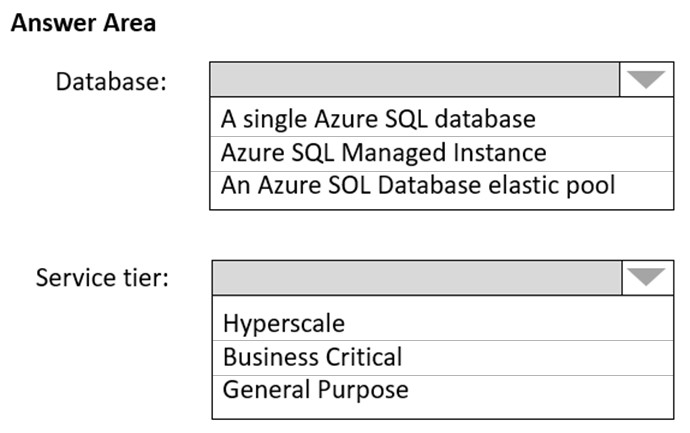
You have an Azure Active Directory (Azure AD) tenant named contoso.com that has a security group named Group1. Group1 is configured for assigned membership. Group1 has 50 members, including 20 guest users. You need to recommend a solution for evaluating the membership of Group1. The solution must meet the following requirements: ✑ The evaluation must be repeated automatically every three months. ✑ Every member must be able to report whether they need to be in Group1. ✑ Users who report that they do not need to be in Group1 must be removed from Group1 automatically. ✑ Users who do not report whether they need to be in Group1 must be removed from Group1 automatically. What should you include in the recommendation?
A. Implement Azure AD Identity Protection.
B. Change the Membership type of Group1 to Dynamic User.
C. Create an access review.
D. Implement Azure AD Privileged Identity Management (PIM).
You are designing an app that will include two components. The components will communicate by sending messages via a queue. You need to recommend a solution to process the messages by using a First in, First out (FIFO) pattern. What should you include in the recommendation?
A. storage queues with a custom metadata setting
B. Azure Service Bus queues with partitioning enabled
C. Azure Service Bus queues with sessions enabled
D. storage queues with a stored access policy
You have 12 Azure subscriptions and three projects. Each project uses resources across multiple subscriptions. You need to use Microsoft Cost Management to monitor costs on a per project basis. The solution must minimize administrative effort. Which two components should you include in the solution? Each correct answer presents part of the solution. NOTE: Each correct selection is worth one point.
A. budgets
B. resource tags
C. custom role-based access control (RBAC) roles
D. management groups
E. Azure boards
DRAG DROP - You have an Azure subscription. The subscription contains Azure virtual machines that run Windows Server 2016 and Linux. You need to use Azure Monitor to design an alerting strategy for security-related events. Which Azure Monitor Logs tables should you query? To answer, drag the appropriate tables to the correct log types. Each table may be used once, more than once, or not at all. You may need to drag the split bar between panes or scroll to view content. NOTE: Each correct selection is worth one point. Select and Place:
You need to recommend a data storage solution that meets the following requirements: ✑ Ensures that applications can access the data by using a REST connection ✑ Hosts 20 independent tables of varying sizes and usage patterns ✑ Automatically replicates the data to a second Azure region ✑ Minimizes costs What should you recommend?
A. an Azure SQL Database elastic pool that uses active geo-replication
B. tables in an Azure Storage account that use geo-redundant storage (GRS)
C. tables in an Azure Storage account that use read-access geo-redundant storage (RA-GRS)
D. an Azure SQL database that uses active geo-replication
You need to recommend a solution to generate a monthly report of all the new Azure Resource Manager (ARM) resource deployments in your Azure subscription. What should you include in the recommendation?
A. Azure Arc
B. Azure Monitor metrics
C. Azure Advisor
D. Azure Log Analytics
Note: This question is part of a series of questions that present the same scenario. Each question in the series contains a unique solution that might meet the stated goals. Some question sets might have more than one correct solution, while others might not have a correct solution. After you answer a question in this section, you will NOT be able to return to it. As a result, these questions will not appear in the review screen. Your company deploys several virtual machines on-premises and to Azure. ExpressRoute is deployed and configured for on-premises to Azure connectivity. Several virtual machines exhibit network connectivity issues. You need to analyze the network traffic to identify whether packets are being allowed or denied to the virtual machines. Solution: Use Azure Advisor to analyze the network traffic. Does this meet the goal?
A. Yes
B. No
HOTSPOT - You have an Azure subscription. You need to deploy a solution that will provide point-in-time restore for blobs in storage accounts that have blob versioning and blob soft delete enabled. Which type of blob should you create, and what should you enable for the accounts? To answer, select the appropriate options in the answer area. NOTE: Each correct selection is worth one point.
DRAG DROP - You have an on-premises datacenter named Site1. Site1 contains a VMware vSphere cluster named Cluster1 that hosts 100 virtual machines. Cluster1 is managed by using VMware vCenter. You have an Azure subscription named Sub1. You plan to migrate the virtual machines from Cluster1 to Sub1. You need to identify which resources are required to run the virtual machines in Azure. The solution must minimize administrative effort. What should you configure? To answer, drag the appropriate resources to the correct targets. Each resource may be used once, more than once, or not at all. You may need to drag the split bar between panes or scroll to view content. NOTE: Each correct selection is worth one point.
HOTSPOT - You plan to deploy Azure Databricks to support a machine learning application. Data engineers will mount an Azure Data Lake Storage account to the Databricks file system. Permissions to folders are granted directly to the data engineers. You need to recommend a design for the planned Databrick deployment. The solution must meet the following requirements: ✑ Ensure that the data engineers can only access folders to which they have permissions. ✑ Minimize development effort. ✑ Minimize costs. What should you include in the recommendation? To answer, select the appropriate options in the answer area. NOTE: Each correct selection is worth one point. Hot Area:
You need to design a highly available Azure SQL database that meets the following requirements: ✑ Failover between replicas of the database must occur without any data loss. ✑ The database must remain available in the event of a zone outage. ✑ Costs must be minimized. Which deployment option should you use?
A. Azure SQL Managed Instance Business Critical
B. Azure SQL Database Premium
C. Azure SQL Database Basic
D. Azure SQL Managed Instance General Purpose
You have an Azure subscription that contains a storage account. An application sometimes writes duplicate files to the storage account. You have a PowerShell script that identifies and deletes duplicate files in the storage account. Currently, the script is run manually after approval from the operations manager. You need to recommend a serverless solution that performs the following actions: ✑ Runs the script once an hour to identify whether duplicate files exist ✑ Sends an email notification to the operations manager requesting approval to delete the duplicate files ✑ Processes an email response from the operations manager specifying whether the deletion was approved ✑ Runs the script if the deletion was approved What should you include in the recommendation?
A. Azure Logic Apps and Azure Event Grid
B. Azure Logic Apps and Azure Functions
C. Azure Pipelines and Azure Service Fabric
D. Azure Functions and Azure Batch
DRAG DROP - You plan to deploy an infrastructure solution that will contain the following configurations: • External users will access the infrastructure by using Azure Front Door. • External user access to the backend APIs hosted in Azure Kubernetes Service (AKS) will be controlled by using Azure API Management. • External users will be authenticated by an Azure AD B2C tenant that uses OpenID Connect-based federation with a third-party identity provider. Which function does each service provide? To answer, drag the appropriate functions to the correct services. Each function may be used once, more than once, or not at all. You may need to drag the split bar between panes or scroll to view content. NOTE: Each correct selection is worth one point.
You are developing a sales application that will contain several Azure cloud services and handle different components of a transaction. Different cloud services will process customer orders, billing, payment, inventory, and shipping. You need to recommend a solution to enable the cloud services to asynchronously communicate transaction information by using XML messages. What should you include in the recommendation?
A. Azure Notification Hubs
B. Azure Service Fabric
C. Azure Queue Storage
D. Azure Application Gateway
HOTSPOT - You have the resources shown in the following table.You create a new resource group in Azure named RG2. You need to move the virtual machines to RG2. What should you use to move each virtual machine? To answer, select the appropriate options in the answer area. NOTE: Each correct selection is worth one point. Hot Area:
HOTSPOT - Your company develops a web service that is deployed to an Azure virtual machine named VM1. The web service allows an API to access real-time data from VM1. The current virtual machine deployment is shown in the Deployment exhibit.The chief technology officer (CTO) sends you the following email message: "Our developers have deployed the web service to a virtual machine named VM1. Testing has shown that the API is accessible from VM1 and VM2. Our partners must be able to connect to the API over the Internet. Partners will use this data in applications that they develop." You deploy an Azure API Management (APIM) service. The relevant API Management configuration is shown in the API exhibit.
For each of the following statements, select Yes if the statement is true. Otherwise, select No. NOTE: Each correct selection is worth one point. Hot Area:
You need to design a highly available Azure SQL database that meets the following requirements: • Failover between replicas of the database must occur without any data loss. • The database must remain available in the event of a zone outage. • Costs must be minimized. Which deployment option should you use?
A. Azure SQL Database Hyperscale
B. Azure SQL Database Premium
C. Azure SQL Database Basic
D. Azure SQL Database Serverless
You have an Azure subscription that contains 1,000 resources. You need to generate compliance reports for the subscription. The solution must ensure that the resources can be grouped by department. What should you use to organize the resources?
A. application groups and quotas
B. Azure Policy and tags
C. administrative units and Azure Lighthouse
D. resource groups and role assignments
HOTSPOT - You need to recommend a solution to integrate Azure Cosmos DB and Azure Synapse. The solution must meet the following requirements: • Traffic from an Azure Synapse workspace to the Azure Cosmos DB account must be sent via the Microsoft backbone network. • Traffic from the Azure Synapse workspace to the Azure Cosmos DB account must NOT be routed over the internet. • Implementation effort must be minimized. What should you include in the recommendation? To answer, select the appropriate options in the answer area. NOTE: Each correct selection is worth one point.
Overview - Contoso, Ltd. is a research company that has a main office in Montreal. Existing Environment - Technical Environment - The on-premises network contains a single Active Directory domain named contoso.com. Contoso has a single Azure subscription. Business Partnerships - Contoso has a business partnership with Fabrikam, Inc. Fabrikam users access some Contoso applications over the internet by using Azure Active Directory (Azure AD) guest accounts. Requirements - Planned Changes - Contoso plans to deploy two applications named App1 and App2 to Azure. App1 - App1 will be a Python web app hosted in Azure App Service that requires a Linux runtime. Users from Contoso and Fabrikam will access App1. App1 will access several services that require third-party credentials and access strings. The credentials and access strings are stored in Azure Key Vault. App1 will have six instances: three in the East US Azure region and three in the West Europe Azure region. App1 has the following data requirements: Each instance will write data to a data store in the same availability zone as the instance. Data written by any App1 instance must be visible to all App1 instances. App1 will only be accessible from the internet. App1 has the following connection requirements: Connections to App1 must pass through a web application firewall (WAF). Connections to App1 must be active-active load balanced between instances. All connections to App1 from North America must be directed to the East US region. All other connections must be directed to the West Europe region. Every hour, you will run a maintenance task by invoking a PowerShell script that copies files from all the App1 instances. The PowerShell script will run from a central location. App2 - App2 will be a .NET app hosted in App Service that requires a Windows runtime. App2 has the following file storage requirements: Save files to an Azure Storage account. Replicate files to an on-premises location. Ensure that on-premises clients can read the files over the LAN by using the SMB protocol. You need to monitor App2 to analyze how long it takes to perform different transactions within the application. The solution must not require changes to the application code. Application Development Requirements Application developers will constantly develop new versions of App1 and App2. The development process must meet the following requirements: A staging instance of a new application version must be deployed to the application host before the new version is used in production. After testing the new version, the staging version of the application will replace the production version.The switch to the new application version from staging to production must occur without any downtime of the application. Identity Requirements - Contoso identifies the following requirements for managing Fabrikam access to resources: Every month, an account manager at Fabrikam must review which Fabrikam users have access permissions to App1. Accounts that no longer need permissions must be removed as guests. The solution must minimize development effort. Security Requirement - All secrets used by Azure services must be stored in Azure Key Vault. Services that require credentials must have the credentials tied to the service instance. The credentials must NOT be shared between services. You need to recommend a solution that meets the application development requirements. What should you include in the recommendation?
A. the Azure App Configuration service
B. an Azure Container Registry instance
C. deployment slots
D. Continuous Integration/Continuous Deployment (CI/CD) sources
You need to design a highly available Azure SQL database that meets the following requirements: • Failover between replicas of the database must occur without any data loss. • The database must remain available in the event of a zone outage. • Costs must be minimized. Which deployment option should you use?
A. Azure SQL Managed Instance Business Critical
B. Azure SQL Managed Instance General Purpose
C. Azure SQL Database Standard
D. Azure SQL Database Premium
HOTSPOT - Your company, named Contoso, Ltd., has an Azure subscription that contains the following resources: • An Azure Synapse Analytics workspace named contosoworkspace1 • An Azure Data Lake Storage account named contosolake1 • An Azure SQL database named contososql1 The product data of Contoso is copied from contososql1 to contosolake1. Contoso has a partner company named Fabrikam Inc. Fabrikam has an Azure subscription that contains the following resources: • A virtual machine named FabrikamVM1 that runs Microsoft SQL Server 2019 • An Azure Storage account named fabrikamsa1 Contoso plans to upload the research data on FabrikamVM1 to contosolake1. During the upload, the research data must be transformed to the data formats used by Contoso. The data in contosolake1 will be analyzed by using contosoworkspace1. You need to recommend a solution that meets the following requirements: • Upload and transform the FabrikamVM1 research data. • Provide Fabrikam with restricted access to snapshots of the data in contosoworkspace1. What should you recommend for each requirement? To answer, select the appropriate options in the answer area. NOTE: Each correct selection is worth one point.
Your company has the divisions shown in the following table.Sub1 contains an Azure App Service web app named App1. App1 uses Azure AD for single-tenant user authentication. Users from contoso.com can authenticate to App1. You need to recommend a solution to enable users in the fabrikam.com tenant to authenticate to App1. What should you recommend?
A. Enable Azure AD pass-through authentication and update the sign-in endpoint.
B. Use Azure AD entitlement management to govern external users.
C. Configure assignments for the fabrikam.com users by using Azure AD Privileged Identity Management (PIM).
D. Configure Azure AD Identity Protection.
You plan to deploy an application named App1 that will run in containers on Azure Kubernetes Service (AKS) clusters. The AKS clusters will be distributed across four Azure regions. You need to recommend a storage solution to ensure that updated container images are replicated automatically to all the Azure regions hosting the AKS clusters. Which storage solution should you recommend?
A. geo-redundant storage (GRS) accounts
B. Premium SKU Azure Container Registry
C. Azure Content Delivery Network (CDN)
D. Azure Cache for Redis
You need to recommend a solution to generate a monthly report of all the new Azure Resource Manager (ARM) resource deployments in your Azure subscription. What should you include in the recommendation?
A. Azure Arc
B. Azure Log Analytics
C. Application insights
D. Azure Monitor action groups
Note: This question is part of a series of questions that present the same scenario. Each question in the series contains a unique solution that might meet the stated goals. Some question sets might have more than one correct solution, while others might not have a correct solution. After you answer a question in this section, you will NOT be able to return to it. As a result, these questions will not appear in the review screen. You need to deploy resources to host a stateless web app in an Azure subscription. The solution must meet the following requirements: ✑ Provide access to the full .NET framework. ✑ Provide redundancy if an Azure region fails. ✑ Grant administrators access to the operating system to install custom application dependencies. Solution: You deploy a web app in an Isolated App Service plan. Does this meet the goal?
A. Yes
B. No
Access Full AZ-305 Dump Free
Looking for even more practice questions? Click here to access the complete AZ-305 Dump Free collection, offering hundreds of questions across all exam objectives.
We regularly update our content to ensure accuracy and relevance—so be sure to check back for new material.
Begin your certification journey today with our AZ-305 dump free questions — and get one step closer to exam success!


